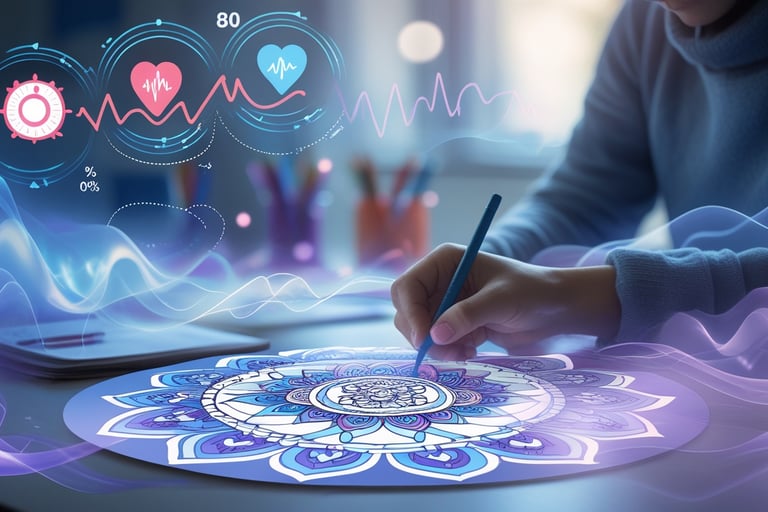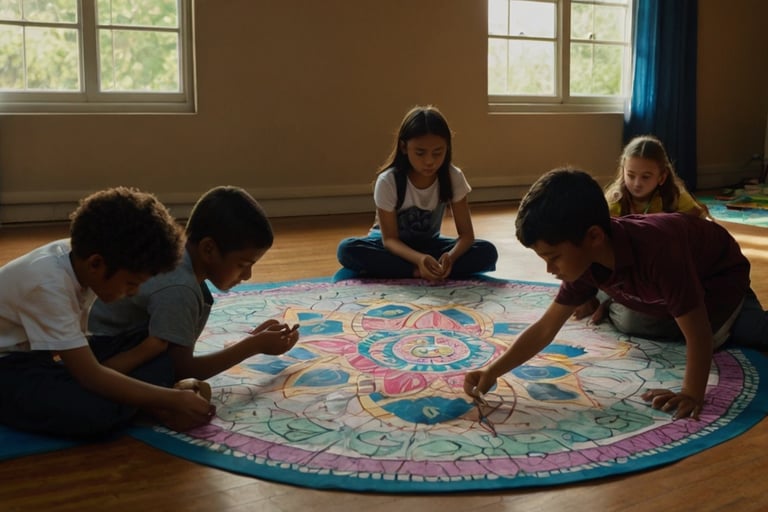The Science Behind Mandalas: Exploring the Cognitive, Emotional, and Neurological Benefits of Geometric Drawing
4/4/20254 min read


Introduction
Mandalas, derived from the Sanskrit word for "circle," are intricate geometric configurations often used in spiritual and meditative practices across cultures. Historically rooted in Hinduism and Buddhism, mandalas have been adopted in modern psychological and therapeutic contexts, particularly in art therapy and mindfulness-based interventions. This article explores the scientific underpinnings and health benefits of mandala drawing, with a focus on cognitive development, emotional regulation, and neurological impact. The argument posited here is that mandalas, beyond being aesthetically pleasing, serve as powerful tools for mental and emotional enhancement, especially among adolescents and learners.
1. Neuropsychological Effects: Enhancing Brain Function
Mandalas engage both the left and right hemispheres of the brain, combining analytical reasoning (symmetry, mathematics) with creative expression (colors, themes). This bilateral brain activation fosters neuroplasticity, which refers to the brain’s ability to rewire itself in response to new experiences and learning environments source: Harvard Health.
Key Outcomes:
Improved working memory
Greater attention span
Faster pattern recognition
Enhanced visual-spatial intelligence
Drawing mandalas activates the prefrontal cortex (linked to planning and attention) and the parietal lobes (associated with spatial reasoning), as shown in fMRI studies examining the cognitive impact of visual arts engagement source: National Library of Medicine.
2. Mandalas and Stress Reduction: The Role of Cortisol and Mindfulness
A landmark study by Curry and Kasser (2005) found that coloring mandalas significantly reduced anxiety compared to free drawing. This aligns with the relaxation response theory proposed by Dr. Herbert Benson, which posits that repetitive, patterned activity (like mandala creation) lowers cortisol levels and elicits a parasympathetic nervous system response source: American Institute of Stress.
How it Works:
Promotes alpha and theta brain wave states akin to meditative mindfulness
Slows heart rate and reduces blood pressure
Lowers stress hormones, improving immune function
Mindfulness interventions using mandalas are also being applied in school-based stress reduction programs, with positive outcomes in managing ADHD, test anxiety, and emotional dysregulation source: Mindfulness Journal.
3. Cognitive and Emotional Development in Adolescents
Mandalas provide an ideal framework for developing executive functions in adolescents, such as planning, inhibition, and cognitive flexibility. According to Piaget’s stages of cognitive development, children aged 11 and up are entering the formal operational stage, capable of abstract and logical reasoning. Mandala-based activities reinforce:
Sequential pattern thinking
Conceptual visualization
Symbolic reasoning
Fine motor precision
Additionally, for children and teens struggling with emotional expression, mandala creation becomes a non-verbal communication tool, a strategy extensively employed in art therapy to uncover latent trauma and promote healing source: American Art Therapy Association.
4. How-To Guide: Implementing Mandala Drawing in Educational or Therapeutic Settings
Educators, psychologists, and parents can integrate mandalas into structured routines to harness their benefits. Below is a step-by-step guide:
Step 1: Create a Calm Environment
Dim lighting, soft instrumental music, and a quiet workspace facilitate focus.
Use guided meditation or breathing exercises to prepare students.
Step 2: Select or Design Mandalas
Use pre-printed geometric mandalas for beginners.
Encourage students to draw their own using rulers and compasses for advanced sessions (introducing math skills).
Step 3: Set Intention
Ask students to associate their mandala with an emotion or theme (e.g., joy, growth, peace).
This engages metacognition and self-reflective awareness.
Step 4: Observe and Reflect
After completion, facilitate a group discussion or journaling about their experiences.
This allows for emotional integration and improves expressive communication.
5. Scientific Benefits Summarized
Benefit Scientific Rationale
Reduces anxiety and stress Activates parasympathetic system, reduces cortisol
Boosts memory and focus Engages hippocampus and prefrontal cortex
Enhances visual-spatial skills Stimulates parietal lobes
Encourages emotional regulation Used in expressive arts therapy; supports affect labeling
Improves fine motor coordination Strengthens hand-eye coordination and cerebellar function
Induces meditative state Activates alpha-theta brain wave transition
Helps ADHD and learning disorders Provides structure and pattern predictability
Stimulates creativity and abstract thought Encourages right-brain dominance and divergent thinking
Enhances sleep and relaxation Mindful drawing before bedtime improves sleep latency
Facilitates symbolic understanding Supports abstraction and cognitive generalization in adolescents
Conclusion: Why Mandalas Matter More Than Ever
In an age of digital distraction, cognitive overload, and rising mental health challenges among youth, mandalas offer a low-cost, research-backed, and engaging solution. They serve not merely as an art form but as a powerful neurological and emotional intervention. Mandala drawing should be embraced in K–12 classrooms, therapy sessions, and mindfulness training programs as a means of enhancing brain function, reducing anxiety, and fostering holistic development.
Incorporating mandalas in structured learning environments is not only scientifically justified but pedagogically necessary to develop emotionally resilient and cognitively empowered learners.
Further Reading and Resources:
Relaxation Response and Mind-Body Medicine
https://www.health.harvard.edu/mind-and-mood/train-your-brain






